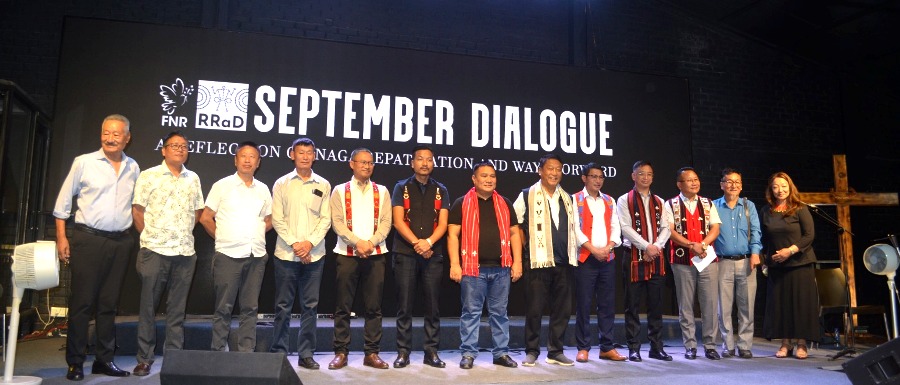Naga leaders reflect on Pitt Rivers Museum visit, urging repatriation of ancestral remains and revival of cultural heritage.
Share

DIMAPUR — The September Dialogue on ‘A reflection on Naga repatriation and ways forward’ provided a platform for the Naga delegation, who had recently visited the Pitt Rivers Museum (PRM), University of Oxford, to reflect on their poignant experience of encountering ancestral remains and artefacts—an encounter that evoked strong emotions and reinforced their commitment to repatriation.
Organised by the Forum for Naga Reconciliation (FNR) and Recover, Restore and Decolonise (RRaD), the dialogue took place on Saturday, September 6, at The Lighthouse Church in Dimapur.
During the session titled ‘Naga tribe leaders reflect on their PRM visit and the Naga collection,’ Phom Peoples’ Council vice president NT Thamlong Phom shared his deeply emotional response to seeing the Naga artefacts and human remains.
Also read: Repatriation process of Naga ancestral human remains: The Journey Forward
He said that witnessing these items without ancestral consent felt profoundly wrong, underscoring the painful legacy of colonialism that has fragmented and dispersed the Naga people.
Thamlong said that the most poignant moment had been connecting with their ancestors’ remains, which seemed to yearn for home.
He added that seeing human skulls, some still with mud attached, suggested violent deaths and intensified the emotional weight of the visit, making it impossible not to feel the impact of history in that room.
Despite the emotional strain, Thamlong expressed gratitude for the preservation of these items. He urged Nagas to unite in the repatriation process to foster healing, promote emotional and physical well-being, and strengthen shared identity beyond geographical and tribal divisions.
Read more: Naga delegation begins historic repatriation process at Oxford’s Pitt Rivers Museum
Presidential council member Tongror Luden Ao Senden, Kumsang Bendangtoshi, described his PRM visit as extraordinary, particularly in seeing over 120-year-old Naga ancestral artefacts.
He highlighted the significance of correcting historical inaccuracies, such as misspelled names on artefacts, marking a step toward reclaiming Naga heritage.
“We meticulously identified which artefacts belong to our people. Each of us received a dossier for reference. I personally confirmed that no human skulls from the Ao community were present—only artefacts gifted by the Ao tribe,” he said, clarifying that the Pitt Rivers Museum does not hold any Ao Naga skulls.
Bendangtoshi encouraged educated youth and students to study these resources to better understand their roots and ancestors.
He suggested that each village make copies of the findings to educate upcoming generations. He also called for unity between the Naga community, the Pitt Rivers Museum, and the government of Nagaland to ensure the safe and dignified return of ancestral remains to their rightful home.
Also read: Rev. Dr. Wati Aier releases book on Naga repatriation and healing
Vice president of Tangkhul Naga Long, Jollyson Ronra Shimray, raised questions about the collection of human remains, stressing the need for respect.
Reflecting on past brutality and its role in dividing the Naga people, he urged the community to focus on solutions that promote unity and healing. “What can we do now to bring our people together?” he asked.
Joint secretary of Sumi Hoho, Hukuto Khulu, underscored the importance of discussions on repatriation, particularly among younger generations. He said that the initiative was not just about human remains but also about reclaiming valuable cultural objects that had been taken without consent.
Hukuto encouraged the community to support repatriation efforts financially and spiritually while recognizing the broader significance of restoring cultural heritage.
Rev. Peihwang Wangsa, representing Konyak Union, reflected on the loss of Naga cultural artefacts due to historical shifts in faith.
He expressed surprise at seeing Naga cultural values preserved in museums abroad, stressing the urgency of repatriation.
Read more: The Naga Oxford Declaration on Repatriation
The Reverend said that many valuable items were held in foreign institutions, leaving the community without tangible connections to their past, and called for collective cooperation to restore the cultural legacy.
Talamong Khiamniungan, executive member of Khiamniungan Tribal Council, explained that during colonial times, the Khiamniungan were recorded as ‘Kalyo-Kengnyu’—named after a mountain.
He noted that even if a person’s remains are not recovered, the community still performs last rites according to tradition. Visiting the PRM, he said, prompted reflection on ancestors’ remains taken without reason, inspiring a commitment to bring them back for respectful burial.
In his closing remarks, Dr. Aküm Longchari, editor and publisher of The Morung Express and FNR member, spoke on the complexity of engaging with the past.
He said that healing was both internal and external, requiring collective reflection and dialogue, and added that churches could serve as safe spaces for truth-telling, where diverse perspectives could be shared without fear or judgement.
Akum highlighted that decolonisation demands confronting difficult questions and embracing discomfort. He stressed a holistic approach to healing, focusing on interconnectedness rather than separating internal and external efforts.
He underscored that reconciliation requires support from institutions, civil society, and the Church, not just tribal cohorts.